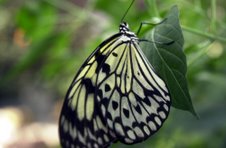
I didn't know what kind of bird it was. I became aware of its presence in our backyard garden in April 2008. I was taking my afternoon siesta then when I awoke to its metallic raspy chirping (I remember hearing those same bird sounds when I took a vacation in Siquijor island years ago). I tried to look for it from inside my room and peeking from the window, saw it: a black and white bird. I was so used to seeing the common Eurasian tree sparrow that this bird's presence was a welcome sight. I had tried getting a photo of it at that time but it was too swift for me.
And yesterday, after hearing its familiar bird call again, I rushed to get my Canon (a Powershot A620) and, finally, I was able to get a photo of this bird. I couldn't get close enough as our two hyperactive dogs were there ready to smother me with their profuse show of canine love. I think I was about 16 feet away when I took the shot (hence, forgive the quality of this photo). And as soon as I could, I searched for a matching photo in the internet (I checked http://www.birdwatch.ph) and finally I was able to identify the bird: a pied fantail!(Rhipidura javanica)
According to wikipedia: "Fantails are small insectivorous birds of southern Asia and Australasia belonging to the genus Rhipidura in the monotypic family Rhipiduridae. Most of the species are about 15 to 18 cm long, specialist aerial feeders, and named as "fantails." The notes from birdwatch.ph says that its habitat include parks, residential areas, thickets and mangroves, and are common in most open areas, constantly flitting out of and among branches, fanning its long white-tipped tail.
The great thing was, that I got a photo, too, of the female pied fantail. Tim Fisher and Nigel Hicks in their book "Birds of the Philippines" said that the fantails occur singly in pairs or small groups. The http://www.birdforum.net described the female of it as having "rusty brown rump, upper tail coverts and wings," and a smaller breast band blotched with white. (do correct me if I have the wrong female bird here).
It's a good thing perhaps that my mother had planted some red hibiscus (which she pruned 'til it grew tall like a tree) in the garden and two Christmas palms and a pair of heliconias. Spiders love spinning their webs around their canopy of leaves. And perhaps the birds could have had their fill of flies in the dung of the pigeons, which my brother kept near the area as well. Haha. What a thought.
So, here they are: the fantail couple in my backyard.





1 comment:
Nice blog. I got a lot of good data. I’ve been following this technology for awhile. It’s interesting how it keeps changing, yet some of the core components remain the same. Have you seen much change since Google made their latest acquisition in the domain?
Post a Comment